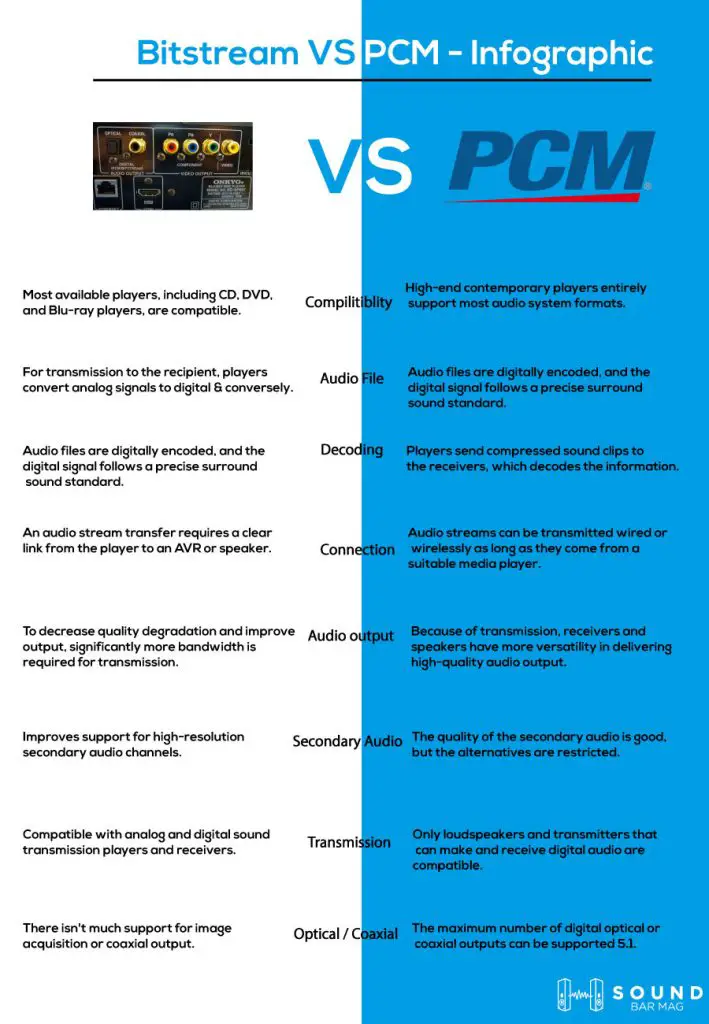If you are looking for bitstream vs. PCM, just read this article. I’ve discovered a wealth of helpful information on this site. Quality knowledge like this isn’t always easy to come by, so it’s good to know it is out there.
I’ll explain the differences between a bitstream and PCM. I’ll compare these two items and explain their likes and dislikes.
Bitstream VS PCM – Side-by-Side Comparison
We’ve now viewed both of them separately. So, in the debate between bitstream and PCM,
Both transmission techniques have benefits and drawbacks, but that does not make one superior to the other. In truth, the output you’ll hear whether you utilise PCM and bitstream for the same audio file on the same speakers would most probably be about.
| Features | PCM | BITSTREAM |
| Compilitiblity | Most available players, including CD, DVD, and Blu-ray players, are compatible. | High-end contemporary players entirely support most audio system formats. |
| Audio File | For transmission to the recipient, players convert analog signals to digital & conversely. | Audio files are digitally encoded, and the digital signal follows a precise surround sound standard. |
| Decoding | Audio files are digitally encoded, and the digital signal follows a precise surround sound standard. | Players send compressed sound clips to the receivers, which decodes the information. |
| Connection | An audio stream transfer requires a clear link from the player to an AVR or speaker. | Audio streams can be transmitted wired or wirelessly as long as they come from a suitable media player. |
| Audio output | To decrease quality degradation and improve output, significantly more bandwidth is required for transmission. | Because of transmission, receivers and speakers have more versatility in delivering high-quality audio output. |
| Secondary Audio | Improves support for high-resolution secondary audio channels. | The quality of the secondary audio is good, but the alternatives are restricted. |
| Transmission | Compatible with analog and digital sound transmission players and receivers. | Only loudspeakers and transmitters that can make and receive digital audio are compatible. |
| Optical / Coaxial | There isn’t much support for image acquisition or coaxial output. | The maximum number of digital optical or coaxial outputs can be supported 5.1. |
Bitstream (Bit Stream)
A bitstream, or sequential sequence, converts input signals into digital bits (or what we often hear as 1s and 0s). It’s the basis for PCM and another high-resolution audio transmission, but that doesn’t make this technology obsolete.
Although bitstream provides fewer options for audio transmission, the sound output is virtually identical to PCM and may even offer more frequencies.
When you enable bitstream broadcasting on a device, the player sends reduced audio files towards the receiver. Your AVR will then decode the info for raw output. We employ this technology to create audio system formats from the player towards the AVR, AV preamplifier, processor, and preamplifier combination.
When a receiver is set to the bitstream, the AV processor is activated to recognize any encoded audio system format received from the player. Based on instructions in the signal, the processor will decode the file.
Higher-end receivers may have a post-processing capability that converts the digital stream to analog, allowing the music to be amplified for greater output.
Among the most popular audio system formats that benefit from the bitstream are Dolby Digital Extra, Dolby TrueHD, Dolby, Dolby Vision EX, Dolby Atmos, DTS HD Master Audio, DTS:X DTS, DTS-ES, and DTS 96/24.
• It can be used with either digital optical or coaxial wires.
• Low degradation of quality.
• It can be used to listen to music wirelessly.
• The capability for secondary audio channels is limited.
• Analog sound transmission is not supported.
PCM (Pulse-Code Modulation)
PCM stands for Pulse Code Modulation, and it is a method used by electronics to represent analog waves. This technique has sent audio streams for nearly a century but is currently the industry norm.
Whether you send encoded or unencrypted audio files makes no impact because PCM is an algorithm. Before delivering data to your receiver, a gadget decodes the data it receives.
When transferring audio in the PCM format, the device decodes the file before sending this to the receiver. This method holds whether you’re using a conventional PCM with amplitude-based quantization levels or an LPCM (Linear Pulse Position Modulation) with linear convolution layers.
You’ll be able to change the sound signal to PCM when connecting your stereo amplifiers to a Blu-ray player. All audio files, especially Dolby, Dolby Improved Definition, DTS, and DTS HD Master Sound, will be decoded by your player.
Your player then will broadcast these encoded audio files to most of the listeners in your home theatre system, uncompressed. Consequently, once your AVR obtains the audio file, it doesn’t have to do anything. It’ll only function if these are delivered to your speakers for output.
Because CD players frequently employ this form of connection, most AVRs are PCM compatible. It is the most widely used means of sending audio signals because it works well with analog and digital input.
• Support for additional audio channels is excellent.
• Sound transmissions are received in both analog and digital formats.
• Digital optical and coaxial output ability is restricted.
• To avoid quality degradation, sufficient bandwidth is required.
Bitstream and PCM Similarities
Although Bitstream and PCM are vastly different, the two are very similar when it relates to audio production. Consider the following similarities when deciding which choice is best for you:
- Both offer excellent audio quality.
- Both Bitstream and PCM files can be played on most DVD or Blu-ray devices.
- Both impulses should be converted to analog form to be heard via the speakers.
You can also visit our detailed comparison guide on the Bitstream Dolby VS DTS and PCM Audio VS Dolby Digital.

Related Posts:
- PCM VS Passthrough Soundbar [Detailed-Guide]
- PCM or Raw for Soundbar – [Detailed-Guide]
- Bitstream or PCM for Soundbar
- Is PCM Better than Dolby Digital? [Detailed-Guide]
- PCM vs Dolby Digital Sound Bar – Which One is Better?
Conclusion
If we compare the output that each can provide, there is no clear winner in the bitstream vs. PCM dispute. The judgement is based on how you want to set up your audio system or where you intend to utilise it.
PCM is the way to go if you want a system that can handle high-resolution secondary audio. If we employ standard sound systems, both transmission techniques can supply you with a hi-res output. However, if you’ve spent a lot of money on a high-end sound system, bitstream will allow you to use superior audio codecs.
I hope this article about bitstream vs. PCM was helpful to you. I found plenty of great information vital for any beginning or advancing video game enthusiast. This piece covered everything from the difference between the two items to the likes and dislikes.

Mia Evelyn is a soundbar specialist and she love to test and review different soundbar brands. She shares her neutral and in-depth reviews through the Soundbar Mag.